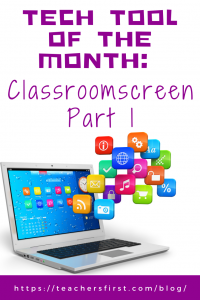Classroomscreen is an online class organization and management tool that can be used in the classroom, on a whiteboard, or virtually. Classroomscreen allows you to create a background screen with up to 13 widgets (timer, drawing tool, random name selector, traffic light, text box, polls, and much more)—you can keep the widgets of your choice and hide the others. The tool will also create student groups for you! The free version of this tool is an excellent way to organize your remote learning lessons—check out this page with clear instructions for implementing this tool during distance learning.
Applying the Triple E Framework
The Triple E Framework, created by Dr. Liz Kolb, is built on the belief that “effective technology integration begins with good instructional strategies and not fancy tools” (tripleeframework.com). Dr. Kolb wrote a book on the topic, Learning First, Technology Second (ISTE, 2017), that lays out the three main uses for technology in education: to Engage, Enhance, or Extend learning goals. We can use this framework to decipher why we are using specific tools in the classroom. Here is a rubric based on the Triple E Framework you can use to evaluate whether Classroomscreen (or any other technology) is a good fit with your learning goals and whether you should use Classroomscreen in your lesson.
- Engage in learning goals: When using Classroomscreen, students are more focused on the task because they have fewer distractions. Teachers can decide which widgets are on the screen at any given time, giving them the ability to remove distracting widgets. Many of the widgets save time, but they also help motivate students to begin the learning process because they engage students with polls, keep them on task with notes, show videos directly, and more.
- Enhance learning goals: This tool enhances learning goals by using the widgets to scaffold lesson content. For example, teachers can include widgets such as a text box with instructions of what work should be completed today, a widget for a YouTube video related to the lesson, and a poll to use as an exit ticket. Many of the widgets and features allow students to demonstrate a more sophisticated understanding of the content. The activities (many shown on widgets) are not isolated in workbooks or stand-alone, but are rather connected and weaved together on the virtual screen.
- Extend learning goals: Dr. Kolb describes extended learning as an opportunity for students to learn, connect, and collaborate outside of the regular school day and as a bridge between the school day and real-life experiences. The activities and widgets available with Classroomscreen would fit well in flipped, blended, and remote learning lessons, which would allow for connection outside of the traditional regular day.
SAMR Connection
The SAMR Model, by Dr. Ruben Puentedura, suggests that technology implementation has four levels. We can use this model as a guideline to analyze how we’re using technology tools in the classroom. Depending on how you are using Classroomscreen, this tool could be at the level of Augmentation or Modification.
- Augmentation: At this level, technology acts as a direct substitute for a tool but provides functional improvements. Classroomscreen has many widgets available with functions that could be done without technology, but the technology offers improved functionality. For example, you could set a physical timer or simply tell students they have 10 minutes to complete a task, but the timer widget offers a functional improvement by giving students a visual reminder to keep them on track.
- Modification: At this level, technology allows us to significantly change the tasks associated with an activity, meaning the activity could not be done without technology. Many functions of the widgets would not be possible without technology, such as the sound level widget, which gives students a visual if the noise gets too loud and a bell that rings if the level gets too high. Other examples include the virtual poll and QR code generator.
Don’t miss Part 2 of the Tech Tool of the Month: Classroomscreen, where we’ll discuss how to use the tool and introduce ways to use it in the classroom. In the meantime, let us know in the comment section below how you have used Classroomscreen in your education setting.



One thought on “Tech Tool of the Month: Classroomscreen – Part 1”